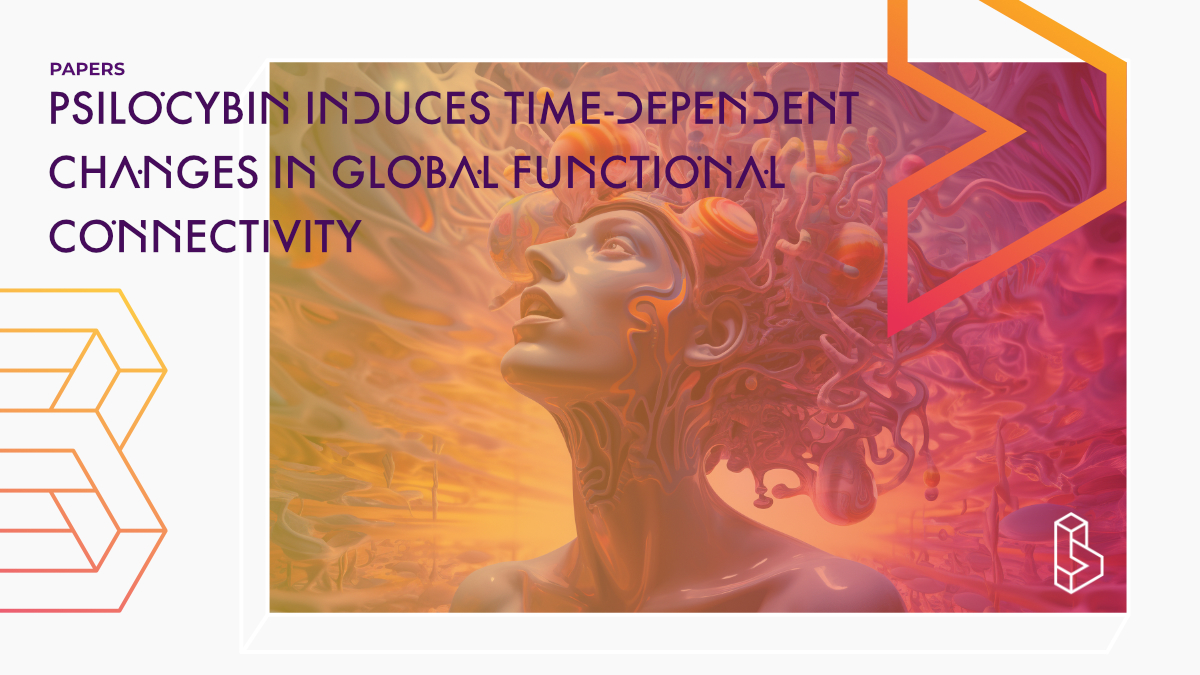This double-blind, placebo-controlled fMRI study (n=23) study with psilocybin (14mg/70kg) finds evidence that sensory connectivity increased whilst associative connectivity went down.
Abstract of Psilocybin induces time-dependent changes in global functional connectivity
“Background The use of Psilocybin in scientific and experimental clinical contexts has triggered renewed interest in the mechanism of action of psychedelics. However, its time-dependent systems-level neurobiology remains sparsely investigated in humans.
Methods We therefore conducted a double-blind, randomized, counterbalanced, cross-over study during which 23 healthy human participants received placebo and 0.2 mg/kg of psilocybin p.o. on two different test days. Participants underwent MRI scanning at three time points between administration and peak effects: 20 mins, 40 mins, and 70 mins after administration. Resting-state functional connectivity was quantified via a data-driven global brain connectivity method and compared to cortical gene expression maps.
Results Psilocybin reduced associative, but concurrently increased sensory brain-wide connectivity. This pattern emerged over time from administration to peak-effects. Furthermore, we show that baseline connectivity is associated with the extent of Psilocybin-induced changes in functional connectivity. Lastly, Psilocybin induced changes correlated time-dependently with spatial gene expression patterns of the 5-HTR2A and 5-HTR1A.
Conclusions These results suggest that the integration of functional connectivity in sensory and the disintegration in associative regions may underlie the psychedelic state and pinpoint the critical role of the serotonin 2A and 1A receptor systems. Furthermore, baseline connectivity may represent a predictive marker of the magnitude of changes induced by psilocybin and may therefore contribute to a personalized medicine approach within the potential framework of psychedelic treatment.“
Authors: Katrin H. Preller, Patricia Duerler, Joshua B. Burt, Jie Lisa Ji, Brendan Adkinson, Philipp Stämpfli, Erich Seifritz, Grega Repovš, John H. Krystal, John D. Murray, Alan Anticevic & Franz X. Vollenweider
Notes on Psilocybin induces time-dependent changes in global functional connectivity
This work was supported, in part, by the Heffter Research Institute.
An interesting point is made in the discussion. If we can (easily) measure baseline connectivity, it might be possible to predict therapeutic outcomes (or adjust treatment for the most effective therapeutic outcomes).
“[W]e show that participants who at baseline had the lowest values in hyper-connected areas also had the highest values in hypo-connected regions. These individuals then displayed the strongest Psi-induced changes in GBC at T3 (Figure 4). Therefore, baseline functional connectivity could be an individual predictive marker of the strength of Psi-induced effects. This is particularly important because the strength of Psi effects has been positively associated with treatment response in patients with end-of-life anxiety and depression. Investigating baseline connectivity before treatment could therefore contribute to a personalized medicine approach within the framework of psychedelic therapy.”
Summary of Psilocybin induces time-dependent changes in global functional connectivity
Psilocybin is a serotonergic psychedelic substance that has recently re-gained scientific attention due to promising first results suggesting clinical efficacy in psychiatric disorders. However, the neurobiology underlying Psi-induced effects in human is still poorly understood.
Previous studies have shown that Psi increases functional connectivity between the default-mode network (DMN) and the task-positive network (TPN), and that there is a wider repertoire of connectivity states between four pre-specified regions of interest (ROIs) after Psi administration. However, these studies have not investigated the association between Psi and receptor pharmacology.
Find this paper
https://doi.org/10.1016/j.biopsych.2019.12.027
Paywall | Google Scholar | Backup | 🕊
Cite this paper (APA)
Preller, K. H., Duerler, P., Burt, J. B., Ji, J. L., Adkinson, B., Stńmpfli, P., ... & Vollenweider, F. X. (2020). Psilocybin induces time-dependent changes in global functional connectivity. Biological psychiatry, 88(2), 197-207.
Study details
Compounds studied
Psilocybin
Topics studied
Neuroscience
Healthy Subjects
Study characteristics
Original
Placebo-Controlled
Double-Blind
Within-Subject
Randomized
Participants
23
Humans
Authors
Authors associated with this publication with profiles on Blossom
Katrin PrellerKatrin Preller is one of the upcoming researchers, currently at the University of Zurich and Yale University, and is focused on the neurobiology and pharmacology of psychedelics.
Franz Vollenweider
Franz X. Vollenweider is one of the pioneering psychedelics researchers, currently at the University of Zurich. He is also the director of the Heffter (sponsored) Research Center Zürich for Consciousness Studies (HRC-ZH).
Institutes
Institutes associated with this publication
University of ZurichWithin the Department of Psychiatry, Psychotherapy and Psychosomatics at the University of Zurich, Dr Mialn Scheidegger is leading team conducting psychedelic research and therapy development.
Compound Details
The psychedelics given at which dose and how many times
Psilocybin 14 mg | 1xLinked Research Papers
Notable research papers that build on or are influenced by this paper
Comparing neural correlates of consciousness: from psychedelics to hypnosis and meditationThis comparative neuroimaging study (n=107) compares the neural correlates of two pharmacological methods, psilocybin (n=23) and LSD (n=25), and two non-pharmacological methods, hypnosis (n=30) and meditation (n=29), in inducing altered states of consciousness (ASC). The results reveal distinct connectivity patterns associated with pharmacological and non-pharmacological interventions, predictability at an individual level, and unique behavioural-neural relationships between psilocybin and LSD, all contributing to a broader understanding of the mechanisms of ASC and their potential therapeutic applications in psychiatric disorders.
Linked Clinical Trial
Beyond the Self and Back: Neuropharmacological Mechanisms Underlying the Dissolution of the SelfThe aim of the study is to identify neural signatures, behavioral and phenomenological expressions of self-related processes including: sense of agency, semantic distinction between self and other, selflessness (altruism), social agency, embodied self (interoception), perceptual functioning of dissolved self including hallucinations and crossmodal processing, and finally the mystical type dissolution of the self.

